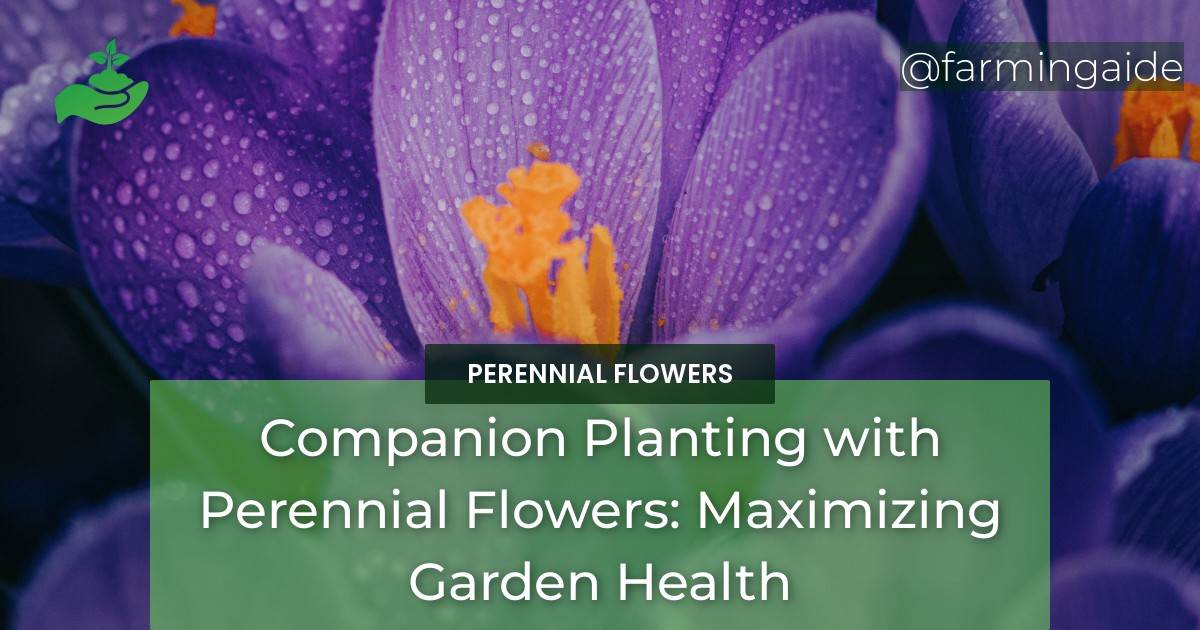Companion planting is a technique that has been used for centuries to maximize garden health through the strategic placement of different plants. By using companion planting, gardeners can create a more diverse and sustainable ecosystem within their garden. Perennial flowers are a popular choice when it comes to companion planting, as they offer a range of benefits that can help to improve garden health. In this article, we will discuss the benefits of companion planting with perennial flowers and provide an overview of some of the most popular types of perennial flowers that can be used in this way.
Benefits of Companion Planting with Perennial Flowers
Increased biodiversity
Perennial flowers are known for their ability to attract beneficial insects and pollinators to the garden. By doing so, they can help to create a more diverse ecosystem within the garden, which can have a range of benefits. For example, having a diverse range of insects and other creatures in the garden can help with natural pest control, as predators will be present to help keep pest populations in check. Additionally, a more diverse ecosystem can help to improve soil health and reduce the risk of plant disease.
Natural pest control
Some types of perennial flowers are known for their ability to repel certain pests. For example, marigolds are known for their ability to deter nematodes, while catnip can help to keep aphids and other insects at bay. By incorporating these flowers into your garden design, you can reduce the need for chemical pest control methods and create a more sustainable garden environment.
Soil improvement
Perennial flowers can help to improve soil health through a process known as nitrogen fixation. Certain types of perennial flowers are able to take nitrogen from the air and convert it into a form that can be used by plants. Additionally, many types of perennial flowers are able to cycle nutrients through the soil, which can help to improve overall soil health and reduce the need for fertilizers.
Extended blooming
Using perennial flowers in your garden design can help to extend the blooming season, providing food and habitat for pollinators for a longer period of time. Additionally, a garden filled with blooming flowers is a beautiful thing to behold, and can provide a sense of joy and peace to those who spend time in it.
Types of Perennial Flowers for Companion Planting
Coneflowers
Coneflowers are a popular choice for companion planting, as they are known for their ability to attract bees, butterflies, and other pollinators. They are also relatively low-maintenance, making them a great choice for gardeners who are new to companion planting. To incorporate coneflowers into your garden design, consider planting them in clumps of three or more, as this can help to create a more attractive visual effect.
Black-eyed Susans
Black-eyed Susans are another popular choice for companion planting, as they are known for their ability to attract a wide range of pollinators. They are particularly attractive to bees and butterflies, and can help to provide a food source for these important creatures throughout the growing season. To incorporate black-eyed susans into your garden design, place them in a location that receives full sun, and consider planting them near other flowering plants to create a cohesive look.
Bee Balm
Bee balm is a great choice for gardeners who are looking to attract pollinators to their garden, as it is known for its ability to attract bees, butterflies, and hummingbirds. It is also a great choice for natural pest control, as it can help to keep mosquitoes and other unwanted insects at bay. To incorporate bee balm into your garden design, plant it in a location that receives partial sun and provide it with well-draining soil.
Lupines
Lupines are a great choice for gardeners who are looking to improve soil health, as they are able to fix nitrogen in the soil and help to cycle other nutrients through the soil as well. They are also attractive to pollinators and can help to create a more diverse ecosystem within the garden. To incorporate lupines into your garden design, plant them in a location that receives full sun and provide them with well-draining soil.
Coreopsis
Coreopsis is a great choice for gardeners who are looking to extend the blooming season in their garden, as it is known for its ability to bloom from summer through fall. It is also attractive to a range of pollinators and can help to create a more diverse ecosystem within the garden. To incorporate coreopsis into your garden design, plant it in a location that receives full sun and provide it with well-draining soil.
ALSO READ
How can Perennial Flowers be Used for Maximizing Garden Health in Specific Container Placements for Full Sun Plants?
Perennial flowers are ideal for specific container placements for full sun, as they can thrive in the bright, direct sunlight. By strategically placing these flowers in containers, garden health can be maximized. The right combination of perennials can create a beautiful and low-maintenance garden that flourishes in full sun conditions.
Conclusion
Companion planting with perennial flowers can be a great way to improve garden health and create a more sustainable garden environment. By using the right types of perennial flowers in your garden design, you can attract pollinators, repel pests, improve soil health, and extend the blooming season. We encourage gardeners to try incorporating perennial flowers into their garden design for improved garden health.


